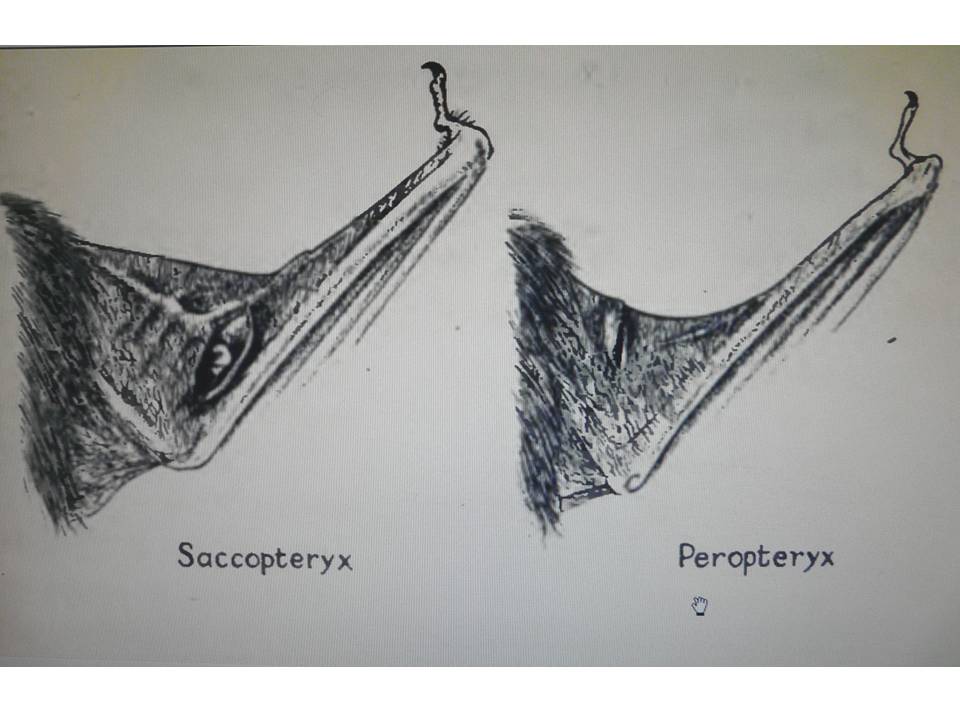

Click on the species links for access to the image gallery.
Click on the HBook icon on the right hand side for access to pdfs of the FAUNA Paraguay Handbook of the Mammals of Paraguay Volume 3 Chiroptera Part 1: Emballonuridae, Noctilionidae and Phyllostomidae.
See below for a key to the Paraguayan species.
EMBALLONURIDAE - SAC-WINGED BATS
General characteristics: A single insectivorous species characterized by the moist gland located on the wing membrane in front of the elbow. It is a small bat with a simple, non-warty facial structure and snout extending slightly beyond the lower lip with nostrils pointing forwards. The ear is broad and triangular traversed by broad parallel lines. The eye is large, pointed at the inner corner so it is somewhat teardrop-shaped. The pelage is dense and long. The tail is very short, well-enclosed by the tail membrane (uropatagium) but the tip points out of it slightly on the dorsal side. The uropatagium reaches to the feet when extended, but at rest the membrane contracts significantly so that the tip of the tail may appear to extend beyond it. Calcar is relatively long. Roosting Sac-wings adopt a characteristic head-down posture with arms and legs spread into a cross-shape, and are often found in well-lit areas. When disturbed they shake rhythmically. Roosts consist of several females and only a single male, suggesting that harem formation is part of the social structure. Typically this species is active before dark, flying with rapid, butterfly-like wingbeats and retracing the same flight trajectory over and over. They are difficult to capture away from the roost because of their habit of flying high.
Cranial characteristics: Well-developed post-orbital processes, relatively narrow and blunt. Adults with incomplete premaxillaries, retaining only the nasal portion and not fused either to the maxillaries or to each other. Sagittal crest present. Snout rises relatively abruptly towards brain case. Basysphenoid processes not divided.
Skeletal characteristics: Wing digit II consists only of the metacarpal.
Dental characteristics: Dental formula I1/3 C1/1 P2/2 M3/3 = 32.
Genetic characteristics:
Ecology:
Reproductive Biology:
Reproductive Biology:
Physiology:
Parasites:
Evolution of Sac-winged Bats:
Taxonomy:
Web Resources:
Subfamily Emballonurinae Gervais, 1856
Cranial characteristics: Characterised by long, curved postorbital processes.
Skeletal characteristics: Clavicle narrow with greatest width approximately 1/6 of its total length. Tibia subterete or with outer side flattened.
Taxonomy: All the species that occur or could occur in Paraguay belong to the subfamily Emballonurinae and tribe Diclidurini (Lim et al 2008). One genus and one species present in Paraguay. Two further species are of possible occurrence in Paraguay though they have yet to be recorded. Rhynchonycteris naso and Saccopteryx bilineata have been recorded in Bolivia in southeastern Brazil close to the Paraguayan border, albeit at slightly higher altitudes than those commonly found in Paraguay.
Peropteryx W.Peters, 1867: Dog-like Bats
Synonyms:
Vespertilio Wied-Neuwied 1826:262. In part. Not Vespertilio Linnaeus 1758.
Proboscidea Gray 1838:499. In part. Not Proboscidea Spix 1823.
Emballonura Temminck 1838:22. In part.
Peropteryx W.Peters 1867:472. Type species Vespertilio caninus Schinz 1821 by original description.
Peronymus W.Peters 1868:145. Type species Peropteryx leucoptera W.Peters 1867 by monotypy. Described as a subgenus of Peropteryx W.Peters 1867.
Saccopteryx Dobson 1878:373. In part. Not Saccopteryx Illiger 1811.
Peropterix Trajano & Moreira 1991:16. Incorrect spelling.
Pteropteryx López-González 2005:13. Incorrect spelling.
General characteristics: Small bats with a sac on the wing that opens outwards close to the upper edge of the propatagium (Fig 1). Females are larger than males in most dimensions. Sac is reduced in females but well-developed in males. Ears are well-separated. Wing membrane attach to the leg at the distal end of the tibia.
Cranial characteristics: Lateral pterygoid fossae are small. The rostrum is expanded anteriorly and there is a distinct angle between the rostrum and forehead. The dorsal profile is approximately parallel to the row of maxillary teeth. Postorbital processes short. Barisphenoid pit undivided.
Dental characteristics: Anterior upper premolar spicule-like.
Peropteryx macrotis - Peters´ Sac-winged Bat
Key to Adults of Sac-winged Bats Considered of "Probable Occurrence" in Paraguay
Only Peropteryx macrotis has been confirmed as present in Paraguay but two further species are considered of "probable occurrence" by López-González (2005) and a key to separate these three species is provided below. Note that the family account above refers in large part to Peropteryx macrotis.
1a Tufts of white hairs on forearms. Two faint, undulating white lines on lower back. Glandular sacs not present on forearm membrane of either sex. Forearm <42mm. Nose greatly elongated and trunk-like extending well beyond lips. Calcaneous c3x length of foot.................................................................................Rhynchonycteris naso
1b No white tufts on forearms. Dorsal surface unstriped. Glandular sacs present on forearm membrane of males (Fig 1). Forearm typically <45mm. Snout pointed but extending only slightly beyond lips. Calcaneous c2x length of foot.........................................................................................................................Peropteryx macrotis
1c No white tufts on forearms. Dorsal surface with two conspicuous longitudinal white stripes. Glandular sacs present on forearm membrane of males (Fig 1). Forearm typically >45mm. Calcaneous c2x length of foot............................................................................................................................................Saccopteryx bilineatus
REFERENCES
Emmons LH & Feer F 1999 - Mamíferos de los Bosques Húmedos de América Tropical - FAN Bolivia.
Lim BK, Engstrom MD, Bickham JW, Patton JC 2008 - Molecular Phylogeny of New World Sheath-tailed Bats (Emballonuridae: Diclidurini) Based on Loci from the Four Genetic Transmission Systems in Mammals - Biological Journal of the Linnean Society 93: p189-209.
López-Gonzalez C 1998 - Systematics and Zoogeography of the Bats of Paraguay - PhD Thesis Texas Tech University
López-Gonzalez C 2005 - Murciélagos del Paraguay - Biosfera 9.
Redford K 1992 - Mammals of the Neotropics Vol 2: The Southern Cone Chile, Argentina, Uruguay and Paraguay - University of Chicago Press.
Sanborn CC 1937 - American Bats of the Subfamily Emballonurinae - Fieldiana Zoology 20 number 24.

FIG 1: Comparison of position of wing sacs in Saccopteryx and Peropteryx taken from Sanborn (1933).
Designed by Paul Smith 2006. This website is copyrighted by law.
Material contained herewith may not be used without the prior written permission of FAUNA Paraguay.
Photographs on this web-site and are used with permission.



